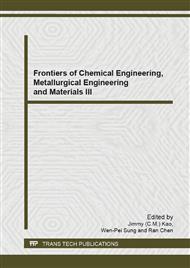p.346
p.350
p.356
p.359
p.363
p.368
p.371
p.375
p.379
Selection of Ion Exchange Resins for Tungsten and Molybdenum Separation
Abstract:
A solution containing tungsten and molybdenum was acidified using hydrochloric acid, and the ability of several commercial ion exchange resins to separate tungsten and molybdenum was evaluated. The results from the acidification test indicate that when the pH of the solution is adjusted to 7.0, WO42- is polymerized into HW6O215-, while MoO42- is not. The test results of resins selection show that the D213 resin and the D308 resin are superior to other resins in separating low concentrations of tungsten and molybdenum, whereas the D201 resin and the D309 resin are suitable for separating high concentrations of tungsten and molybdenum. The results from the column test indicate that weak-base anion exchange resins are better than strong-base anion exchange resins for both low and high concentrations of tungsten and molybdenum.
Info:
Periodical:
Pages:
363-367
Citation:
Online since:
August 2014
Authors:
Keywords:
Price:
Сopyright:
© 2014 Trans Tech Publications Ltd. All Rights Reserved
Share:
Citation:


